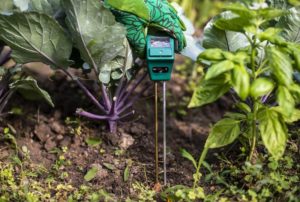Peat moss is very different from traditional compost, it decomposes over a long period of time and is made out of almost solely moss material.

Mixing Peat Moss with Garden Soil
Peat moss is acidic and therefore is often used as a pH amender, perfect for growing vegetables and other low pH level plants. If your plants prefer alkaline soil, you will be better off going for a traditional compost rather than peat moss so as not to lower the pH level too much.
Gardeners also use peat moss for changing the texture of the soil. For example, thick, clay-like soil can be mixed with peat moss to lighten it and give it a more fluffy texture. If your soil is dry and crumbly, mixing some peat moss in with it will help it hold its shape and retain moisture.
Have you ever tried to grow plants from seeds? It’s not as easy as it sounds right! Peat moss mixed in with soil of your choice is extremely beneficial for new seedlings. Naturally, peat moss is very sterile and doesn’t promote fungal growth or bacterial buildup near the seed. Another reason peat moss is so good for growing seeds is that it created a great soil texture that is perfect for supporting new roots.

How to Mix Peat Moss With Soil (Step-by-Step)
Now for the important part. We have looked into what peat moss is and all of its benefits in the garden, but how do we actually mix it in with the soil?
There are a few methods, if you are looking to spruce up your soil texture a little and improve moisture retention in the soil then use the ratio 2:1 – two parts soil to one part peat moss. You can tweak this formula as you see fit, depending on your soil conditions.
If you are looking to plant seeds, follow this peat moss and soil mixing guide to get a great soil mix that your seeds will love:
- Mix 4 parts peat moss, 3 parts of garden soil, and 3 parts compost in a bucket.
- Moisten the mix using a hose or a few cups of water depending on the quantities you are producing. Wet the mix until it is damp, not saturated.
- Mix the contents of the bucket well until all of the mixtures is damp.
- Place the mixture on a baking tray and heat in the oven for sterilization.
- Heat the mixture in the oven until it reaches a maximum temperature of 180 degrees Fahrenheit.
- Let the mix cool for at least an hour.
- Once cool, place the mixture in pots and start panting.
Reasons Not to Use Peat Moss On its Own
Peat moss should never be used on its own, the main reason being that it is a natural material and will decompose quickly when exposed to the right elements. Although peat moss takes a while to decompose when mixed with other substances, on its own it can decompose at a very fast rate.
When peat moss decomposes it becomes denser and compresses, causing the plant roots to suffocate. This doesn’t happen when it is mixed with soil because it isn’t exposed to so much air when used as part of a soil mix.
Hydroponic growing methods do not use soil, this is a way of growing plants in a nutrient-rich water base with a mixture of peat moss, rock wool, clay pellets, and other natural ingredients. Even during hydroponic plant growth, peat moss is rarely used alone.
Pros of Using Peat Moss:
- Peat moss doesn’t make a mess
- Great water retention qualities
- Doesn’t contain weed seeds
- It is sterile
- Free of artificial chemicals
- Readily available
- Very acidic and can alter the pH level of the soil
- Loosens compact soil and makes it more breathable
Cons of Using Peat Moss:
- Doesn’t contain many nutrients
- If it dries, it takes a long time to absorb water again
- Not all plants like an acidic environment
- High price point
- Non-renewable







Isis, I like this post and learning from you. It makes me feel good to see what I am doing wrong and right in my garden. Thanks for this post. Gary